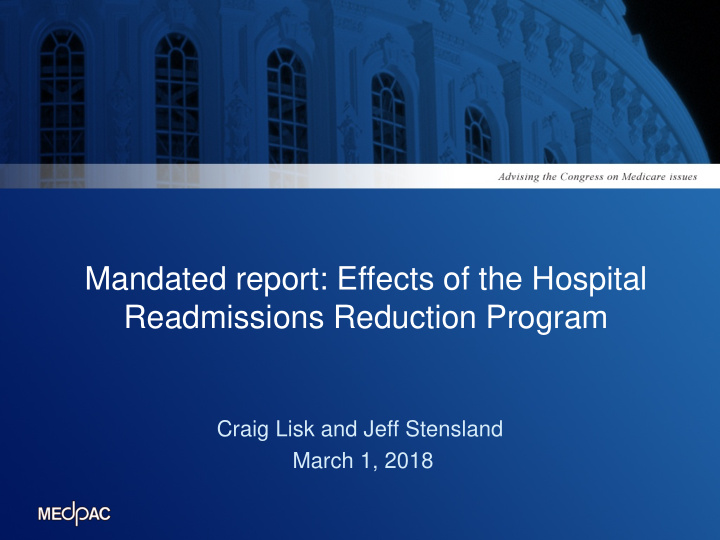



Mandated report: Effects of the Hospital Readmissions Reduction Program Craig Lisk and Jeff Stensland March 1, 2018
The 21 st Century Cures Act mandated readmissions study Mandated study question: Are reduced readmissions “related to changes in outpatient and emergency services”? This report examines relationships between changes in readmissions and Observation stays Emergency department visits Mortality 2
Refinements to the draft report In response to the January meeting’s discussion: Use non-HRRP conditions as the comparison group in the graphics Examined change in rate of decline in hospital readmissions before and after program enactment Readmission rates declined faster after program enactment Added discussion to the chapter Updated the literature review Findings unchanged 3
Raw readmission rates after passage of the HRRP 0.20 0.18 Unplanned readmission rate 0.16 0.168 0.167 0.168 0.167 0.164 0.159 0.158 0.156 0.14 0.150 0.12 0.10 0.08 0.06 No HRRP PPACA passes HRRP penalties begin 0.04 0.02 0.00 2008 2009 2010 2011 2012 2013 2014 2015 2016 Results are preliminary and subject to change 4
Raw readmission rates declined for each condition covered by HRRP 0.30 Unplanned readmission rate 0.25 0.20 0.15 No HRRP PPACA passes HRRP penalties begin 0.10 0.05 0.00 2008 2009 2010 2011 2012 2013 2014 2015 2016 AMI Heart failure Pneumonia COPD Hip and knee replacement Other conditions Results are preliminary and subject to change 5
Risk-adjusted readmission rates fell faster for conditions covered by the HRRP 0.30 0.25 Unplanned readmission rate 0.20 0.15 No HRRP PPACA passes HRRP penalties begin 0.10 0.05 0.00 2008 2009 2010 2011 2012 2013 2014 2015 2016 AMI Heart failure Pneumonia COPD Hip and knee replacement Other conditions Results are preliminary and subject to change 6
Growth in observation and ED use was not driven by the HRRP program Overall observation and ED visits increased from 2010 to 2016 (overall, meaning not just post-discharge visits) Observation stays overall increased by 1.9 per 100 beneficiaries ED visits overall increased by 5.4 visits per 100 beneficiaries Growth in use of observation and ED began before the HRRP passed Similar growth for beneficiaries without an admission, suggesting the HRRP program did not drive the increase Results are preliminary and subject to change 7
Risk-adjusted use of observation and ED grew the same for conditions covered and not covered by the HRRP 5 initial conditions Conditions not included in HRRP 3.0 2.1 2.1 2.0 Percentage point change, 2010 to 2016 1.1 1.0 1.0 0.6 0.1 0.0 -1.0 -2.0 -2.5 -3.0 -3.1 -4.0 Risk-adjusted unplanned readmission rate 8 hour plus observation (post-discharge) ED (post-discharge) Return to the hospital (sum of all three) Results are preliminary and subject to change 8
Raw mortality rates, 2008 to 2016 0.25 0.20 Raw mortality rate 0.15 0.10 0.05 No HRRP PPACA passes HRRP penalties begin 0.00 2008 2009 2010 2011 2012 2013 2014 2015 2016 AMI Heart failure Pneumonia Non-HRRP conditions Note: Raw mortality includes in-hospital and 30 days after discharge Results are preliminary and subject to change 9
Risk-adjusted mortality rates declined from 2008 to 2016 0.25 0.20 Risk-adjusted mortality rate 0.15 0.10 0.05 No HRRP PPACA passes HRRP penalties begin 0.00 2008 2009 2010 2011 2012 2013 2014 2015 2016 AMI Heart failure Pneumonia Non-HRRP conditions Note: Risk-adjusted mortality includes in-hospital and 30 days after discharge Results are preliminary and subject to change 10
Readmission policy refinements Refine the penalty formula (eliminate the multiplier) Expand to all conditions to pay for fixing the penalty formula Fixed target Adjust penalties to account for SES (implemented as part of the 21 st Century Cures Act) 11
Readmission program has been largely successful The HRRP created an incentive to reduce readmissions Readmissions declined (at least partially due to the HRRP) Observation and emergency visits increased, but may be largely due to reasons other than the HRRP HRRP did not appear to negatively affect mortality rates While successful, the HRRP still could be refined 12
Recommend
More recommend